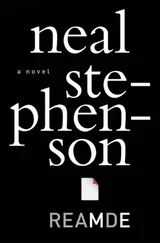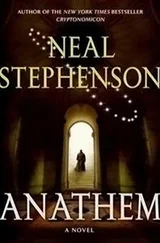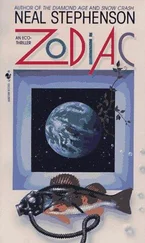The pumps are mighty, house-sized things; they have to be to fight the back-pressure that they are going to engender. Goto Dengo's young engineers see to it that they are mated into the two vertical holes on top: one to supply compressed air, the other pressurized fuel oil. Doug Shaftoe would like to be involved in this, but he knows it's over his head technically, and he's got other duties: securing the defensive perimeter against gold-seekers and whatever creepy-crawly individuals Wing might have sent out to harass and sabotage them. But Doug has put the Word out, and a whole lot of Doug's very interesting and well-traveled friends have converged on Golgotha from all over the world and are now camped out in foxholes in the jungle, guarding a defensive perimeter strung with monofilament tripwires and other stuff that Randy doesn't even want to know about. Doug just tells him to stay away from the perimeter, and he does. But Randy can sense Doug's interest in the central project here, and so when the big day comes, he lets Doug be the one to throw the switch.
There is a lot of praying first: Avi's brought in a rabbi from Israel, and Enoch Root has brought in the Archbishop of Manila, and Goto Dengo has flown in some Shinto priests, and various Southeast Asian countries have gotten in on the act too. All of them pray or chant for the memory of their departed, though the prayers are practically drowned out by the choppers overhead. A lot of people don't want them disturbing Golgotha at all, and Randy thinks they are basically right. But he's gone out and earth-imaged Wing's tunnel, this subterranean tentacle of air reaching towards the hoard, and released three-dimensional maps of everything to the media, and made the case—reasonably well, he thinks—that it's better to do something constructive than to let it get ripped off by the likes of Wing. Some people have come around to his side and some haven't, but none of the latter group is on the cover of Time and Newsweek.
Doug Shaftoe is the last guy to take the floor. He removes his mesh-back cap, puts it over his heart, and with tears streaming down his face says something about his father, whom he just barely remembers. He speaks of the Battle of Manila and of how he saw his father for the first time in the wreckage of the Church of San Agustin, and how his father carried him up and down the stairway there before going off to bring hellfire down upon the Nipponese. He speaks about forgiveness and certain other abstractions, and the words are all chopped up and blurred by the helicopters overhead, which only makes it more powerful as far as Randy's concerned, since it's basically all about a bunch of memories that are all chopped up and blurred in Doug's memory to begin with. Finally Doug works his way around to some kind of resolution that is very clear in his heart and mind but poorly articulated, and hits the switch.
The pumps take a few minutes to pressurize Golgotha with a highly combustible mixture of air and fuel oil, and then Doug hits another switch that sets off a small detonation down below. Then the world shudders and rumbles before settling down into a kind of suppressed throbbing howl. A jet of white-hot flame shoots out of the drain hole down below, digs itself into the river very close to where Andrew Loeb came to rest, and throws up a cloud of steam that forces all of the choppers to gain altitude. Randy crawls down under the cover of that steam-cloud, sensing it's the last privacy he'll ever have, and sits down by the edge of the river to watch. After half an hour the jet of hot gas is joined by a rivulet of incandescent fluid that sinks to the bottom of the stream as soon as it emerges, clothed in a fuzz of wildly boiling water. For a long time there is really nothing to be seen except steam; but after Golgotha's been burning for an hour or two, it becomes possible to see that underneath the shallow water, spreading down the valley floor, indeed right around the isolated boulder where Randy's perched, is a bright, thick river of gold.
APPENDIX: THE SOLITAIRE ENCRYPTION ALGORITHM
by Bruce Schneier
Author, Applied Cryptography
President, Counterpane Systems
http://www.counterpane.com
In Neal Stephenson's novel Cryptonomicon, The character Enoch Root describes a cryptosystem code-named “Pontifex” to another character named Randy Waterhouse, and later reveals that the steps of the algorithm are intended to be carried out using a deck of playing cards. These two characters go on to exchange several encrypted messages using this system. The system is called “Solitaire” (in the novel, “Pontifex” is a code name intended to temporarily conceal the fact that it employs a deck of cards) and I designed it to allow field agents to communicate securely without having to rely on electronics or having to carry incriminating tools. An agent might be in a situation where he just does not have access to a computer, or may be prosecuted if he has tools for secret communication. But a deck of cards… what harm is that?
Solitaire gets its security from the inherent randomness in a shuffled deck of cards. By manipulating this deck, a communicant can create a string of “random” letters that he then combines with his message. Of course Solitaire can be simulated on a computer, but it is designed to be implemented by hand.
Solitaire may be low-tech, but its security is intended to be high-tech. I designed Solitaire to be secure even against the most well-funded military adversaries with the biggest computers and the smartest cryptanalysts. Of course there is no guarantee that someone won't find a clever attack against Solitaire (watch my web page for updates), but the algorithm is certainly better than any other pencil and paper cipher I've ever seen.
It's not fast, though. It can take an evening to encrypt or decrypt a reasonably long message. In David Kahn's book Kahn on Codes, he describes a real pencil-and-paper cipher used by a Soviet spy. Both the Soviet algorithm and Solitaire take about the same amount of time to encrypt a message.
ENCRYPTING WITH SOLITAIRE
Solitaire is an output-feedback mode stream cipher. Sometimes this is called a key-generator (KG in U.S. military speak). The basic idea is that Solitaire generates a stream, often called a “keystream,” of numbers between 1 and 26. To encrypt, generate the same number of keystream letters as plaintext letters. Then add them modulo 26 to plaintext letters, one at a time, to create the ciphertext. To decrypt, generate the same keystream and subtract modulo 26 from the ciphertext to recover the plaintext.
For example, to encrypt the first Solitaire message mentioned in Stephenson's novel, “DO NOT USE PC”:
1. Split the plaintext message into five character groups. (There is nothing magical about five-character groups; it's just tradition.) Use X's to fill in the last group. So if the message is “DO NOT USE PC” then the plaintext is:
DONOT USEPC
2. Use Solitaire to generate ten keystream letters. (Details are below.) Assume they are:
KDWUP ONOWT
3. Convert the plaintext message from letters into numbers: A = 1, B = 2, etc:
4 15 14 15 20 21 19 5 16 3
4. Convert the keystream letters similarly:
11 4 23 21 16 15 14 15 23 20
5. Add the plaintext number stream to the keystream numbers, modulo 26. (All this means is, if the sum is more than 26, subtract 26 from the result.) For example, 1 + 1 = 2, 26 + 1 = 27, and 27 – 26 = 1, so 26 + 1 = 1.
15 19 11 10 10 10 7 20 13 23
6. Convert the numbers back to letters.
OSKJJ JGTMW
If you are really good at this, you can learn to add letters in your head, and just add the letters from steps (1) and (2). It just takes practice. It's easy to remember that A + A = B; remembering that T + Q = K is harder.
Читать дальше





